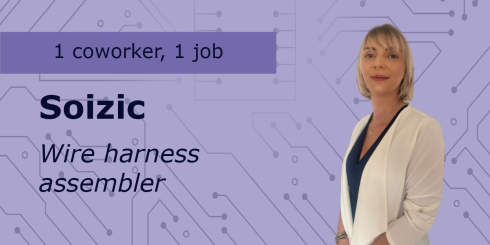Soizic shares her daily life at éolane as a wire harness assembler
Can you introduce yourself?
I arrived at the Neuilly-en-Thelle site after completing my high school diploma. My mother and sister were already working here. Through word of mouth, I joined the company in 2003 as a temporary worker in a SMT (Surface Mount Technology) position. Over the past 18 years, I have held various roles. Initially, I worked as a machine operator, and then I became a SMT line controller.
Reporting to the Production Manager, this role offered me more freedom as I could independently manage my production line: programming, screen printing, component adjustment, oven processing, and post-oven quality control. It was rewarding to have complete control over my production line.
Subsequently, I transitioned to a role in component placement and finishing. I underwent a one-month training to become more comfortable in this role, ultimately ending up in an integration position.
What was your first impression when you arrived at éolane?
I arrived at a family-owned company, a small factory where everyone knows each other, and I quickly integrated. I learned about new techniques from the more experienced colleagues. I don't have any degrees in electronics, engineering, or soldering; I learned everything on the job!
Can you describe a typical day for a wire harness assembler?
In the morning, I retrieve the assembly file provided by the methods department, and I meticulously follow the instructions. I have the tools provided and the prescribed methods to follow, so I simply need to adhere to the instructions for the assembly.
I work on all the stages except for testing. I can do wrapping, which is a technique where the wire is wrapped around a connector; it's not soldering, mind you! It's a method of encircling using a gun. I also perform crimping, which involves crimping a wire into a terminal using a crimping tool.
Lastly, I perform torque tightening, which means tightening based on the client's technical specifications. I'm not allowed to tighten as I please; I must adhere to the instructions provided by the client in my assembly file.
In summary, I do a lot of assembly, fastening, and crimping.
Which departments do you interact with?
I work with the Methods department because if we encounter any issues or have remarks about the instructions, they can assist us in understanding the assembly file. We are also in contact with the Quality department, which helps resolve our manufacturing issues and inspects the finished product. We often need to visit the Warehouse department to retrieve Manufacturing Orders and receive bulky products.
In your opinion, what are the qualities required to be an operator?
It's a hands-on job, so you need to be very meticulous and composed, especially when we're soldering. laughs
Concentration and precision are crucial for this profession; you can't afford to be scattered, as you might miss important steps. I like to be organized in my work, and we use the 5S method a lot: sort, set in order, shine, standardize, and sustain.
On the contrary, do you have any constraints to mention?
It's a physically demanding job; we handle heavy loads daily, such as 4-meter-long tags, and we may have to carry them multiple times a day. Good physical condition is essential. The working hours, whether during the day or night, should also be considered when pursuing this profession.
A final word to conclude?
We've organized several events on-site: bingo, Christmas meals, barbecues, and so on. These are wonderful memories shared among colleagues!

